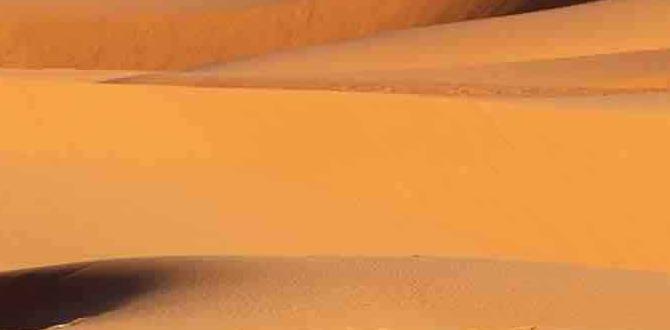Yes, solo female travel in the Atacama Desert is safe and incredibly rewarding with proper preparation. This guide offers essential tips for enjoying the world’s driest desert confidently, covering everything from planning and packing to staying safe and making the most of your adventure.
Dreaming of vast salt flats, star-filled skies, and Martian landscapes? The Atacama Desert in Chile offers this and so much more. It’s a destination that calls to the adventurous spirit. For solo female travelers, the idea might bring a few questions, especially concerning safety and ease of travel in such a unique environment.
But don’t let that hold you back! With a little planning and these essential tips, your solo journey through the Atacama can be a truly unforgettable and empowering experience. Let’s get you ready for an incredible adventure.
Why Solo Travel to the Atacama Desert is a Fantastic Idea
The Atacama Desert might seem remote, but it’s surprisingly well-equipped for tourists. Its unique geological formations, clear night skies perfect for stargazing, and vibrant local culture make it a captivating destination. For solo female travelers, it offers a chance for introspection, personal growth, and connection with nature unlike anywhere else.
The infrastructure in popular hubs like San Pedro de Atacama is geared towards visitors, and its laid-back atmosphere fosters a sense of community among travelers, making it easier to meet like-minded people if you wish.
Planning Your Atacama Solo Adventure
A little pre-trip planning goes a long way in ensuring a smooth and enjoyable experience. Focusing on key aspects like timing, logistics, and accommodation will set you up for success.
Best Time to Visit
The Atacama Desert experiences a relatively stable climate year-round, but the best times to visit for comfortable temperatures and clear skies are generally between March and May (autumn) and September and November (spring). During these months, daytime temperatures are pleasant, and nighttime temperatures are less extreme. Summer (December to February) can be very hot, while winter (June to August) brings colder nights. However, even in winter, daytime is often sunny and mild, and the clear winter skies offer exceptional stargazing opportunities.
Getting to San Pedro de Atacama
The primary gateway to the Atacama Desert is the town of San Pedro de Atacama. Here’s how to get there:
- Fly into Calama: The nearest airport is El Loa Airport (CJC) in Calama. Several airlines operate flights from Santiago (SCL), Chile’s capital.
- Transfer from Calama to San Pedro: Once you land in Calama, you’ll need transportation to San Pedro de Atacama, which is about a 1.5-hour drive. Shared shuttle services are readily available at the airport and are a convenient and affordable option. You can pre-book these online or arrange them upon arrival.
- From Argentina/Bolivia: It’s also possible to reach San Pedro de Atacama via bus from neighboring countries like Bolivia (Uyuni) or Argentina. These are often longer, more adventurous routes.
Accommodation Options for Solo Travelers
San Pedro de Atacama offers a range of accommodations to suit different budgets and preferences. As a solo female traveler, prioritizing safety and comfort is key.
- Hostels: These are excellent for solo travelers looking to meet people. Many hostels in San Pedro are well-regarded for their cleanliness, security, and social atmosphere. Look for those with good reviews that specifically mention safety for solo women.
- Guesthouses (Hostals) and Boutique Hotels: A step up from hostels, these offer more privacy while often still providing opportunities to connect with other travelers or friendly staff. They can offer a good balance of comfort and affordability.
- Mid-Range Hotels: If you prefer more amenities and privacy, there are comfortable mid-range hotels available.
When booking, always check recent reviews, paying attention to comments on security, location, and staff helpfulness.
Essential Packing List for the Atacama Desert
The Atacama Desert’s extreme climate requires thoughtful packing. You’ll need to be prepared for intense sun, dry air, and significant temperature fluctuations between day and night.
Clothing Layers are Key
The key to packing for the Atacama is dressing in layers. Temperatures can swing dramatically from scorching hot during the day to freezing at night, even within the same day.
- Base Layers: Lightweight, moisture-wicking tops and bottoms.
- Mid-Layers: Fleece jackets or sweaters for warmth.
- Outer Layer: A windproof and water-resistant jacket, especially for evenings and higher altitudes.
- Tops: Breathable, long-sleeved shirts to protect against the sun.
- Bottoms: Comfortable hiking pants or convertible pants are ideal. Shorts can be worn during the hottest parts of the day, but long pants offer better sun protection.
- Warm Hat and Gloves: Essential for the cold desert nights and early mornings.
- Sun Hat: Wide-brimmed to protect your face and neck.
Footwear
Comfortable and sturdy footwear is non-negotiable for exploring diverse terrains.
- Hiking Boots: Broken-in hiking boots with good ankle support are recommended for uneven terrain.
- Comfortable Walking Shoes/Sneakers: For town exploration and less strenuous activities.
- Sandals/Flip-flops: For relaxing at your accommodation.
Sun Protection: Your Ultimate Defense
There is virtually no shade and the sun’s rays are incredibly intense at high altitudes. Prioritize these items:
- High SPF Sunscreen: SPF 50 or higher, applied liberally and frequently. The dry air and altitude can intensify sunburn.
- Lip Balm with SPF: Your lips can easily get chapped and burned.
- Sunglasses: Essential for eye protection.
- Wide-Brimmed Hat: As mentioned above, this is crucial.
Health and Personal Care
The dry environment can take a toll. Pack accordingly:
- Moisturizer: To combat dry skin.
- Hand Sanitizer: Always useful when traveling.
- Personal Medications: Bring any prescription or over-the-counter medicines you might need.
- Basic First-Aid Kit: Include bandages, antiseptic wipes, pain relievers, and any personal necessities.
- Eye Drops: The dust can irritate eyes.
- Hydrating Nasal Spray: For dryness.
- Comfort Aids: If you have specific needs for comfort during long travel days or stays, consider carrying items like discreet adult diapers or protective underwear. These offer an added layer of security and comfort, especially when access to restrooms might be limited or for peace of mind during long excursions, ensuring you can focus on the breathtaking scenery without worry.
Other Essentials
- Reusable Water Bottle: Staying hydrated is paramount. Many hostels and accommodations have filtered water dispensers.
- Power Bank: For charging devices on the go, as outlets may not always be available during tours.
- Adapter: Chile uses Type L and Type C plugs.
- Small Backpack/Daypack: For carrying essentials during daily excursions.
- Camera: To capture the spectacular landscapes.
- Headlamp or Small Flashlight: Invaluable for navigating in the dark, especially at a hostel or for stargazing tours.
- Cash: While cards are accepted in many places, smaller establishments and some tour operators may prefer or only accept cash (Chilean Pesos).
Staying Safe as a Solo Female Traveler in the Atacama
Safety is a top priority for any solo traveler, and the Atacama Desert is generally considered a very safe destination. However, practicing smart travel habits will enhance your security and peace of mind.
Be Aware of Your Surroundings
This is standard advice for any travel, solo or not. Be mindful of who is around you, especially in crowded markets or public transport. San Pedro de Atacama is a small town, and petty crime is rare, but it’s always wise to stay vigilant.
Trust Your Intuition
If a situation or person feels off, don’t hesitate to remove yourself from it. Your instincts are your best guide.
Share Your Itinerary
Let a friend or family member back home know your general plans, where you’re staying, and when you expect to be back in touch. Regular check-ins are a good practice.
Book Reputable Tours
When choosing tours for activities like stargazing, geysers, or salt flats, opt for well-established companies with good reviews. Look for operators that prioritize safety and have experienced guides. Many can be booked through your accommodation or in town.
For example, companies operating tours to the El Tatio Geysers or the Salar de Atacama often start very early in the morning. Ensuring your tour operator is reliable means they’ll have proper vehicles, trained drivers, and clear safety protocols for these demanding excursions.
Secure Your Belongings
Use hostel lockers for valuables and keep your passport and significant amounts of cash in a secure place, like a money belt or a locked bag. Be cautious when walking alone at night; while the town is generally safe, stick to well-lit areas.
Altitude Sickness (Soroche)
San Pedro de Atacama itself is at about 2,400 meters (7,900 feet), but many tours go much higher, sometimes up to 5,000 meters (16,400 feet). Altitude sickness can affect anyone regardless of age or fitness. Take it easy on your first day, stay hydrated, avoid alcohol, and consider consulting your doctor about altitude sickness medication, such as Diamox.
Symptoms of altitude sickness include headache, nausea, dizziness, and fatigue. If you experience these, descend to a lower altitude if possible and rest.
Connectivity
Wi-Fi is available in most accommodations and cafes in San Pedro, but it can be spotty, especially during peak times. Mobile service can also be inconsistent outside of town. Consider getting a local SIM card if you need reliable connectivity. For important communications, always have a backup plan.
Must-Do Atacama Experiences for Solo Travelers
The Atacama Desert is packed with incredible sights and activities. Here are some highlights:
1. Stargazing Tours
The Atacama boasts some of the clearest skies on Earth, making it a premier destination for astronomy. Numerous tour operators offer nighttime stargazing excursions. These typically include transport to a dark-sky location, a talk about constellations and celestial bodies, and telescopic viewing. It’s a truly magical experience that’s perfect for solo contemplation.
2. Valle de la Luna (Moon Valley) and Valle de la Muerte (Death Valley)
These iconic valleys near San Pedro offer surreal landscapes that resemble the moon’s surface. You can explore by guided tour, bike, or even on foot. The sunsets here are legendary, painting the sky with vibrant colors over the dramatic rock formations.
3. El Tatio Geysers
One of the highest geyser fields in the world, El Tatio is best visited at sunrise when the geothermal activity is most dramatic. The steam plumes against the dawn sky are a breathtaking sight. Be prepared for very cold temperatures at this altitude (over 4,300 meters / 14,000 feet).
4. Salar de Atacama
Chile’s largest salt flat is a wonder to behold. You can visit lagoons with flamingos (like Laguna Chaxa) and witness the vast expanse of white salt stretching to the horizon. The unique environment is a photographer’s dream.
5. High-Altitude Lagoons (Miscanti & Miñiques)
These stunning turquoise lagoons, set against dramatic volcanic backdrops at high altitudes, are usually part of full-day tours. The clear, crisp air and the vibrant colors are unforgettable.
6. Exploring San Pedro de Atacama Town
Even the town itself is an experience. Wander its dusty streets, visit the local church, browse artisan shops, and sample local cuisine. It’s a relaxed place where you can easily strike up conversations with locals and fellow travelers.
Navigating Tours and Transportation
Most of the main attractions are accessible only via guided tours or by renting a vehicle (which can be expensive and requires confidence on off-road tracks). For solo travelers, tours are often the most practical, safest, and social option.
Booking Tours
- In San Pedro: You’ll find many tour agencies lining the main streets. It’s a good idea to compare prices, itineraries, and what’s included (e.g., entrance fees, meals, guide languages).
- Online: Many operators allow you to book in advance online, which can be beneficial during peak season or if you have specific tours you don’t want to miss. Look for reputable companies with clear booking policies.
- Through Accommodation: Your hostel or hotel can often book tours for you, sometimes with a slight discount.
Tour Types: Group vs. Private
As a solo traveler, joining group tours is the most common and economical choice. This also provides a great opportunity to meet other people. If budget allows and you prefer more flexibility or a personalized experience, you could consider a private tour, perhaps sharing costs with people you meet.
Independent Exploration
Some attractions, like Valle de la Luna and the town itself, are accessible for independent exploration. Renting a bicycle is a popular way to see areas closer to San Pedro. For more distant sites, a 4×4 vehicle rental is an option, but be aware of road conditions and require a valid international driving permit in some cases.
Dealing with the Dry Climate and Its Effects
The Atacama Desert is one of the driest places on Earth, and this extreme dryness can impact your comfort and health if you’re not prepared.
Hydration is Non-Negotiable
Drink more water than you think you need. Carry a filled reusable water bottle everywhere. Dehydration can exacerbate altitude sickness and general discomfort. You’ll find many places offering filtered water refills.
Skin and Lip Care
The dry air pulls moisture from your skin. Use a good moisturizer daily and reapply a thick one before bed. Don’t forget to protect your lips with a balm that contains SPF. It’s also a good idea to pack a small travel-sized hand lotion.
Eye Care
The dust and dryness can make your eyes feel gritty and irritated. Bringing lubricating eye drops can provide significant relief, especially after a day of exploring dusty roads or windy deserts.
Nasal Passages
Some people find the extreme dryness irritating to their nasal passages, leading to nosebleeds or discomfort. A saline nasal spray can help keep these moist and comfortable.
Making the Most of Your Solo Experience
Solo travel in the Atacama offers a unique opportunity for self-discovery and connection.
Embrace Solitude
While you can easily join group tours, also cherish the moments of quiet reflection that the vast, silent desert offers. Find a spot, watch a sunset, and just be present.
Connect with Other Travelers
Hostels and group tours are natural places to meet people. Strike up conversations in common areas, share travel stories, or even team up for a meal. You might find a travel buddy for a specific excursion or simply make new friends.
Engage with Locals
While interactions might be fleeting, a smile and a few basic Spanish phrases can go a long way. The people of San Pedro are generally friendly and proud of their unique region.
Be Flexible
Travel doesn’t always go to plan. Weather can change, tours can be canceled, or you might feel like staying an extra day somewhere. Embracing a flexible attitude will help you navigate any unexpected turns with grace and make your trip more enjoyable.
Food and Dining
San Pedro de Atacama has a growing culinary scene, offering everything from local Chilean specialties to international cuisine. Many restaurants cater to tourists, and you’ll find options for various budgets.
- Local Dishes: Try empanadas, pastel de choclo (corn casserole), and fresh seafood if available.
- Vegetarian/Vegan Options: Increasingly available due to tourist demand.
- Cafes: Great for a quick bite, coffee, and Wi-Fi.
If you’re on a budget, many tour operators include meals on longer excursions, or you can find more affordable eateries slightly off the main tourist drag. Cooking your own meals in a hostel kitchen is also an option.




